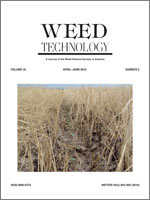Because horsenettle and tall ironweed are difficult to control in cool-season grass pastures, research was conducted in Tennessee and Kentucky in 2010 and 2011 to examine the efficacy of aminocyclopyrachlor on these weeds. Aminocyclopyrachlor was evaluated at 49 and 98 g ai ha−1 alone and in mixtures with 2,4-D amine at 371 and 742 g ae ha−1. Aminopyralid was also included as a comparison treatment at 88 g ai ha−1. Treatments were applied at three POST timings to horsenettle and two POST timings to tall ironweed. By 1 yr after treatment (YAT) horsenettle was controlled 74% with aminocyclopyrachlor plus 2,4-D applied late POST (LPOST) at 98 742 g ha−1. By 1 YAT, tall ironweed was controlled ≥ 93% by aminocyclopyrachlor applied early POST (EPOST) or LPOST, at rates as low as 49 g ha−1. Similar control was achieved with aminopyralid applied LPOST. Both aminocyclopyrachlor and aminopyralid were found to reduce horsenettle and tall ironweed biomass the following year. Moreover, all LPOST applications of aminocyclopyrachlor alone or in mixtures with 2,4-D prevented regrowth of tall ironweed at 1 YAT. Based on these studies, a LPOST herbicide application in August or September when soil moisture is adequate is recommended for control of horsenettle and tall ironweed in cool-season grass pastures.
Nomenclature: 2,4-D; aminocyclopyrachlor; aminopyralid; horsenettle, Solanum carolinense L.; tall ironweed, Vernonia gigantea (Walt.) Trel.
Porque Solanum carolinense y Vernonia gigantea son difíciles de control en pastos de clima frío, se realizó una investigación en Tennessee y Kentucky, en 2010 y 2011, para examinar la eficacia de aminocyclopyrachlor para el control de estas malezas. Aminocyclopyrachlor fue evaluado a 49 y 98 g ai ha−1 solo y en mezclas con 2,4-D amine a 371 y 742 g ae ha−1. Aminopyralid a 88 g ai ha−1 fue también incluido como tratamiento de comparación. Los tratamientos fueron aplicados en tres momentos POST a S. carolinense y dos momentos POST a V. gigantea. A 1 año después del tratamiento (YAT), S. carolinense fue controlada 74% con aminocyclopyrachlor más 2,4-D aplicados en POST tardío (LPOST) a 98 742 g ha−1. A 1 YAT, V. gigantea fue controlada ≥ 93% con aminocyclopyrachlor aplicado en POST temprano (EPOST) o LPOST, a dosis tan bajas como 49 g ha−1. Un control similar fue alcanzado con aminopyralid aplicado LPOST. Se encontró que tanto aminocyclopyrachlor como aminopyralid redujeron la biomasa de S. carolinense y V. gigantea el siguiente año. Además, todas las aplicaciones LPOST de aminocyclopyrachlor solo o en mezclas con 2,4-D previnieron el rebrote de V. gigantea a 1 YAT. Con base en estos estudios, se recomienda una aplicación de herbicida LPOST en Agosto o Septiembre cuando la humedad del suelo es adecuada para el control de S. carolinense y V. gigantea en pastos de clima frío.





